FAQ
Have Any Questions?
Delivery
Delivery outside France
Being the patrickvoillot.com network partners located worldwide, deliveries are carried out by specialized international carriers. The package, confidential and secured, is assured throughout the whole journey until its delivery to the customer.
1 – Delivery to a country in the European Union outside France.
- When your purchase is made with a partner * located in the EU, a delivery within 7 working days is offered to the address you provided. (For orders less than 150 € a 10 € fee is requested). An « express » delivery can be offered, please contact us: contact@patrickvoillot.com
- When your purchase is made with a partner outside EU *: sending in your destination country is offered to you within 10 days.
Your order may be subject to fees consisting of customs duties, import taxes or local taxes that are applied to the package at its arrival in your country. These fees are under your responsibility as much as all the local formalities and any statement in your country. We advise you to check with your country customs and tax authorities, about the local regulations taking place at the time of delivery.
2 – Delivery to a country outside the EU:
- Sending in your country of destination is offered to you within 10 days. Orders from a EU member partner imply an export tariff amount of 110€.
Your order may be subject to fees consisting of customs duties, import taxes or local taxes that are applied to the package at its arrival in your country. These fees are under your responsibility as much as all the local formalities and any statement in your country. We advise you to check with your country customs and tax authorities, about the local regulations taking place at the time of delivery.
Price and taxes
The prices indicated on the website are in Euro (€) and do not include VAT or other local taxes. (Price without VAT or Price excl tax).
Some partners of the network patrickvoillot.com located in France are not subjected to VAT: their billing is always without VAT (Le Récif de Corail, l’île au trésor, Gemmes passion and Brasil Joyo).
1 – Price and VAT for delivery in European Union (excluding France)
For private individuals:
- The Order with a partner from France will be charged: Price + French VAT (20%). (For orders below € 150 a contribution to the costs of shipping of 10 € is requested)
- The Order with a partner from European Union outside France will be charged: Price + VAT of the country where the partner is located. (For orders below € 150 a contribution to the costs of shipping of 10 € is requested)
- The Order of a private individual with a partner outside the European Union will be charged: Price without VAT
It may be subject to fees consisting of customs duties, import taxes or local taxes that are applied to the package at its arrival in the customer’s country. These costs are borne by the customer as much as the local formalities and any statement due in the customer’s country.
For companies with a intra- community VAT number:
- The Order with a partner from France will be charged: net Price (intra-community VAT exempt delivery)
- The Order with a partner from European Union outside France will be charged: net Price (intra-community VAT exempt delivery). Except the cases where the client and the partner are located in the same country of the European Union: in this case the invoice will be : Price + VAT of the country.
- The Order completed with a partner outside the European Union are charged with the net Price.
It may be subject to fees consisting of customs duties, import taxes or local taxes that are applied to the package at its arrival in the customer’s country. These costs are borne by the customer as much as the local formalities and any statement due in the customer’s country.
2 – Prices for delivery outside the European Union
For individuals and businesses the price will be charged net without VAT. Orders from a EU member partner imply an export tariff amount of 110€.
It may be subject to fees consisting of customs duties, import taxes or local taxes that are applied to the package at its arrival in the customer’s country. These costs are borne by the customer as much as the local formalities and any statement due in the customer’s country.
Payments
patrickvoillot.com offers secure payment methods:
- By credit card: Visa – MasterCard – American Express – Blue Credit card with 3D-Secure paybox system, certified to PCI / DSS standards by Visa and Mastercard and ensures compliance with the most stringent safety rules in order to protect the credit card data transmitted during payment transactions.
- By Paypal which has the advantage of paying purchases online without disclosing your bank account details, only using your email address and PayPal password.
- By bank transfer: this method of payment is possible for all orders and is imperative for all orders exceeding € 3,000 excluding VAT.
Our bank details are given to you when finalizing your order.
Whatever the mode of payment chosen, for security reasons, your billing address must be the same as the one on the bank details.
How do you choose a gemstone?
Discover how to choose a precious stone.
1 – The Color
Color is one of the most important characteristics of a gemstone; it is also quite often the criterion for choosing a precious stone.
Certain rubies from Burma are called “pigeon blood”, referring to the precise exceptional red color, recognized by the educated eye of a specialist, yet have nothing to do with the actual color of the animal’s blood. In Burma, the less desirable color is called “Crying Indian » quality, in the local dialect, referring to the fact that Indians buy all types of qualities of gemstones, especially the lowest. Between these two types, the price per carat can range from $1 to $100 000 or more.
This is true for all gemstones. Color is paramount and can sometimes be used to define their origin: as with the sapphire; blue Kashmir, blue Burmese, or blue Ceylon…
For the diamond, colors must be clear: for the white diamond, they must be the purest white; as with tints, their color profoundly distinct: yellow, pink, blue, cognac.
2 – The Weight and Shape
The weight of a stone, estimated in carats (1 carat = 0.2 grams), determines its size, and acts exponentially to determine its price; with equal quality, a 2 carat stone, is worth more than two 1 carat stones. There is even more truth to this equation with rare stones.
As for the shape, with the same weight, a precious stone can be cut into different shapes: brilliant cut, oval, pear, emerald, cushion, etc…
3 -The clarity
The purity determines the transparency, or clarity, and is highly sought after in gemstones.
Carved stones with no inclusions greatly increase their value. In all cases, if there are inclusions, they should not be unsightly; they should not be situated at the level of the ‘table’ (the largest facet on the top of the stone), or on any visible part of the gem after the stone is set.
However, precious stones with inclusions are not always ill-fated. With certain stones, they contribute to their aesthetics; the milky turbulences in the sapphires from Kashmir are famous for contributing a gentle sweetness to their color, and lead them into the rank of the most beautiful sapphires in the world; the emeralds of Columbia, most especially those from the Muzo Mines have inclusions, which experts call « the garden of the emerald”, as they ultimately enrich the beauty of the stone.
4 – The Cut (meaning how the facets are cut by the lapidary or a diamond cutter).
The cut realized by a lapidary, for colored gemstones, or a diamond cutter, for diamonds, must be performed in perfect symmetry and proportion in order to give the best brilliance and fire to a gemstone.
The perfection and the form of the cut also influence the price of a stone. Thus one brilliant cut diamond will have a higher price for the same weight, than that of a fancy cut diamond.
Facets must be regular in their geometry, and well-polished in their totality; the ‘pavillion’ (The lower part on the bottom of the stone, invisible when mounted) must be well balanced, not too deep, and not too shallow. The stone must always be cut in the right areas of the raw crystal so that the color is evenly distributed.
For polychromatic stones like Tanzanite, the cut must be executed precisely in right areas of the crystal axes so that the color of the ‘table’ (stones top main facet) is as pleasant to the eye as possible.
5 – The Place of Purchase and Price
It is important to buy a gemstone in full confidence from a well-known, recognized specialist who will advise you, and in a premise that gives you security with real warranty.
Never buy a valuable stone from a booth or stall at the other end of the world, far from its country of production; you are likely to pay more than its real value!
To purchase a stone of value, do not hesitate to pay for a certificate from an accredited laboratory; but above all, never accept when a local dealer, or so-called unknown specialist, does not even offer a warranty.
These criteria of selection are all very important; but if they do not always meet these categories in their entirety, one must be aware, there are only an infinite percentage of cases of gemstones that are actually exceptional; a great rarity at best.
Thus one must not condemn these precious gems, that sometimes slightly deviate from these criteria, they can also be very beautiful, and quite valuable.
Remember that first and foremost, buying a precious stone, is a journey of the heart, a personal adventure; a sort of bond created between you and the mineral. If this occurs and you have the means, buy the stone that you have touched!
My experience has shown me on numerous occasions; that when you allow this moment to pass, a stone, for a variety of reasons, can cause you eternal regret because you will never rediscover one, which is the same, a second time. Buy the stone that you have touched immediately!
Having your gemstone mounted on a ring?
How to set up the mounting of your gemstone on a ring
On patrickvoillot.com you found the gem you have been looking for a long time … and now you want to get it mounted on a ring.
We offer you different models of rings from Susie Otero and other partners : contact us and tell us which gemstone you want to be mounted and if you have found among our rings the models that you please: let us know which one it is and we will advise.
Tell us your ring finger size, and which stone you want mount …
In any case, there is a solution to showcase your stone according to your wishes.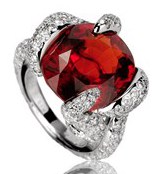
Here Your Ideas….

Susie Otero « solitaire Julia » ring

Susie Otero « solitaire » ring

Susie Otero « liaison » ring

Susie Otero « mille et une nuits » ring

Susie Otero « la vie est belle » ring

Susie Otero « empire » ring
Determine your finger size
Remember that:
- The same finger of the left hand is not the same size as that of the right hand.
- The size of the same finger may vary depending on the temperature or physical activity.
- The best time of the day to determine your finger size is the evening.
- In case of doubt between two sizes, it is advisable to choose the largest.
To help you estimate your ring size we suggest you use the ring sizer on patrickvoiilot.com
- Click the link « ring sizer-patrickvoillot.com » to download the finger chart.
- Print the » ring sizer-patrickvoillot.com » making sure that your printer is set to « Print to real size » and not « Fit to paper ».
- Check that the print was made real size by measuring the control scale that must measure 5 cm.
- Choose a ring that fits perfectly the finger where you want your new ring.
- Move the ring on the colored circles: when a circle is the exact size of the inner ring of your ring, note the number in the circle … that is your size!
The « ring sizer-patrickvoillot.com » is a practical and simple tool for you to estimate your finger size, and not an accurate measure.
Color of the Diamonds
The color of the diamonds is codified by the diamantaires and laboratories issuing certificates of authenticity using specific terms or letters … what do they correspond to?
The positioning of a diamond in the scale of shades of white can only be done by specialists under a specific light and only with unmounted stones.
According to geographical areas of the world, there are different terms that are used ……. to simplify we use 2 of the 3 mainly used for the sale of diamonds:
The letter from the GIA classification « Gemological Institute of America » associated with the name of CIBJO » Confédération Internationale de la Bijouterie- Joaillerie, Orfèvrerie » with the Scandinavian equivalent classification in the table below.
letter code | GIA | CIBJO | Scandinavian Standard |
D | Colorless | Exceptional white + | River |
E | Colorless | Exceptional white | River |
F | Colorless | Extra white+ | Top Wesselton |
G | Near colorless | Extra white | Top Wesselton |
H | Near colorless | White | Wesselton |
I | Near colorless | White shade | Top Crystal |
J | Near colorless | White shade | Crystal |
K – L | Faint/light colored | Slightly Tinted | Top Cape |
Diamonds codified by the letters M and the following are considered « colored » or yellow and cannot be described as » white. «
When a diamond has a plain color shade: yellow, pink, red, blue … we quantify the intensity of its color with the words: « Fancy Light, » « Fancy, » « Fancy intense » and for the more pronounced color « Fancy Vivid » to which, of course, is added its color.
There are also special coding for diamonds from the Australian Argyle mine, which is the largest producer of pink and cognac diamonds … and has created its own coding, the Argyle Scale.
The color of a diamond is also influenced by its fluorescence: lighting rich in ultra-violet type « neon », or daylight mountain light, stimulate fluorescent diamonds and change their color. This therefore ranks diamonds on a scale ranging from « no fluorescence » to « very strong fluorescence. »
In conclusion untrained human eye can only appreciate some groups of shades of color … this is why we often talk about colorless or white diamonds, nearly colorless or shaded white, slightly colored … and also the influence of the shape and the quality of the cut that determines its brilliance, comes into play to guide the pleasure of the happy buyer!
The purity of diamonds and gemstones
Impurities called inclusions in gemstones are even more annoying and visible if the color of the stone is clear and its brightness low, the diamond’s brilliance reduces the effect of small inclusions.
Completely pure gems do not exist … we quantify the inclusions by examining the stones with a loupe with a magnification of 10x and positioning the stone on a scale from purest to less pure.
An internationally agreed codification can position a stone on this scale.
| IF | Internally Flawless | Pure stone, no inclusions visible under 10x magnification. |
| VVS | Very Very Small inclusion(s) | Very very small inclusion(s) or blemishes very difficult to see under 10x magnification. The number and position of tiny inclusions can codify stones « VVS1 » and « VVS2 ». |
| VS | Very Small inclusion(s) | Very small inclusions easily visible under 10x magnification but invisible without magnification. The number and position of very small inclusions or blemishes can codify stones « VS1 » and « VS2 ». |
| SI | Small Inclusions | Small inclusions visible with 10x magnification, almost invisible to the naked eye. Shade « SI1 » and « SI2 » depends on the nature of the inclusions, their number and their position in the stone. In general, these inclusions do not affect the brilliance of diamonds. |
| SI3 | This classification is not recognized by the major laboratories issuing certificates of authenticity, it corresponds to an intermediate position between « SI » and « I ». | |
| I | Included | Gemstones containing inclusions easily visible under magnification10x and with an experienced naked eye. The number, size and position of inclusions determines the codification « I1 » or « I2 ». These inclusions affect the brilliance of the diamonds especially the « I2 ». « I3 » the size of inclusions visible to the naked eye disrupts the brilliance of the stones. Sometimes we use the term » piqué » instead of « I », then we get « Piqué 1 », « Piqué 2″ and » Piqué 3″. |
Types of gems cutting
 |
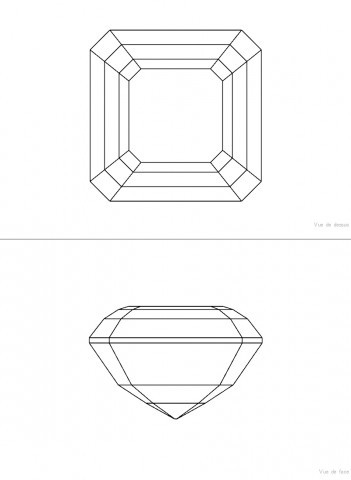 |
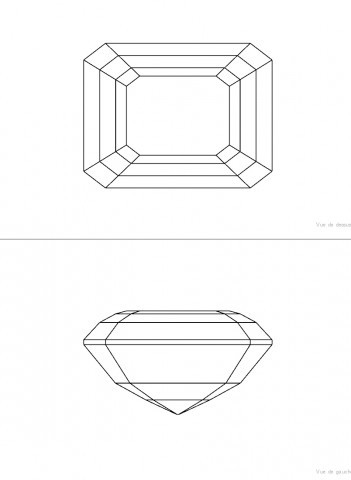 |
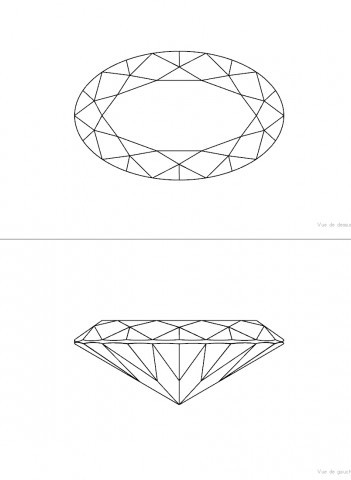 |
| brilliant cut | Asscher cut | emerald cut | oval cut |
 |
 |
 |
 |
| baguette cut | heart cut | pear cut | marquise cut |
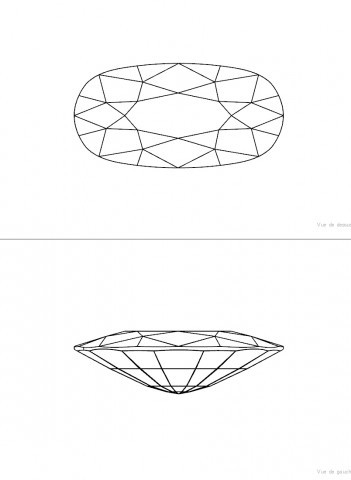 |
 |
 |
 |
| cushion cut | princess cut | briolette cut | radiant cut |
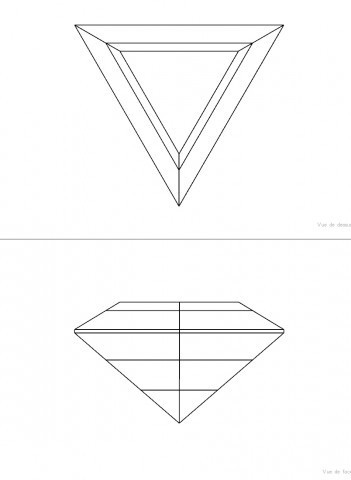 |
 |
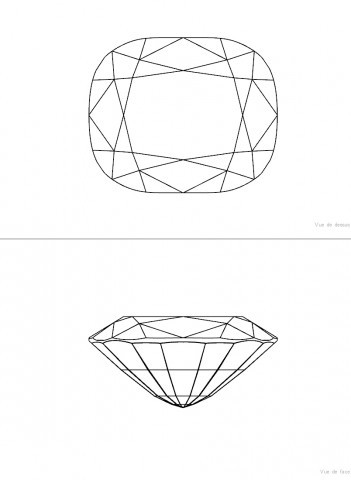 |
 |
| triangle cut | trillion cut | Ceylon cut | Antwerp rose cut |
Certificates of authenticity
Scientific advances of the twentieth century helped to better understand and identify gems, highlight the misidentification of the past on many jewels of royal crowns …
The difference in value between two different gems of the same aspect makes it that the buyer wants to be sure that what he acquires is really that on which he will invest … gemological laboratories fulfill this role. Since the last few decades the scientific equipment available allows competent gemologists to provide essential information:
- Identification of the type of stone: diamond, sapphire, ruby, spinel, emerald …
- Authenticity: natural stone not synthetic.
- Origin: often country or place of origin.
- Treatments (heating or other) that has been sustained by the stone.
- Characteristics of the stone: carat weight, shape and cut, dimensions, quality of the polish and proportions of cut, fluorescence, intensity of the color, transparency, and more specifically for the diamonds color and clarity.
The certificate delivered is a true « identity card » with the characteristics of the stone.
As for the diamond, the price difference between stones of the same weight, but with differences in the shade of white and small differences in purity, is so important that the certificate is especially useful.
All the patrickvoillot.com partners provide their stones accompanied by certificates of authenticity, and for diamonds weighing more than 0.50 ct and other stones worth more than € 1,000, a certificate from an independent quality laboratory we selected can be provided.
The informations on the certificate are secured by processes of the same type as for the banknotes such as laminated paper with holograms or special inserts that are not visible to the eye. The stones can be sealed in plastic … diamonds can even receive an invisible laser engraving carrying the certificate number.



